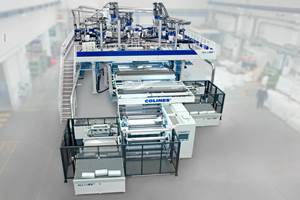Food & Beverage Spending Growth = More Packaging
Bump in spending offsets drop in institutional packaging.
We track three primary industries that drive packaging demand: food, retail (primarily trash and t-shirt bags), and industrial (primarily shipping materials). The food and beverage industry appears to be quite strong right now. However, retail and institutional packaging looks to be fairly weak in the first half of 2017. Let’s dig deeper.
Real Disposable Income. October real disposable income was $12.79 billion (seasonally adjusted at an annual rate), an all-time high. In October, real disposable income grew 2.7% compared with one year ago (most of the last six months were revised upward). The month-over-month rate of growth was below 3% in eight of the last nine months. The annual growth rate has decel- erated steadily since August 2015. In October 2016, the 2.9% annual rate of growth was the slowest since November 2014. Also, this was the fourth month in a row that the annual rate of growth was below 3.1%, the historical average.
Food Packaging. Somewhat surprisingly, real disposable income tends to lead food and beverage spending by almost a year. Food and beverage spending contracted at a very modest rate in 2015. But with the strong growth in income, food and beverage spending has grown at a rapidly accelerating rate. Food and beverage spending has grown above the historical average growth rate for seven months in a row. In October, food and beverage spending grew 5.2% compared with one year ago. The annual rate of growth in October was 2%, which was the fastest growth since December 2014. Food and beverage spending tends to lead food and beverage production. If food and beverage spending continues to grow at an accelerating rate, then food packaging should be poised for further growth in 2017.
Retail Packaging. Probably the best proxy for retail packaging is the clothing and footwear industry. Consumer spending has been growing at a decelerating rate since the fall of 2015. But from last July to October it appeared that the growth in spending compared with a year ago was beginning to level out. The annual growth rate continued to decelerate, but it could flatten out in the first half of 2017. Production of clothing and footwear has been virtually flat over the last six to 12 months. The retail packaging market seems to be flat in the first half of 2017.
Institutional Packaging. This category consists primarily of stretch film, sheet, and tubing, but consumer and industrial product liners and shrink film also are a significant part of this segment. Since all of this packaging is used to ship products, tracking the changes in the trucking industry can provide a good estimate of what is happening with institutional packaging.
The U.S. Bureau of Transportation Services computes a transportation index specifically for the freight industry. This index has come down somewhat from its record highs. Compared with a year ago, the index has declined in three of the last five months.
Year over year, the index has contracted four months in a row. This is not surprising since consumer spending growth has been relatively weak. It’s likely that shipping, and therefore institutional packaging, will remain weak in the first half of 2017.
ABOUT THE AUTHOR: Steven Kline Jr. is part of the fourth-generation ownership team of Cincinnati-based Gardner Business Media, which is the publisher of Plastics Technology. He is currently the company’s director of market intel- ligence. Contact: (513) 527-8800 email: skline2@gardnerweb.com blog: gardnerweb.com/economics/blog
Related Content
Automotive Awards Highlight ‘Firsts,’ Emerging Technologies
Annual SPE event recognizes sustainability as a major theme.
Read MoreSolve Four Common Problems in PET Stretch-Blow Molding
Here’s a quick guide to fixing four nettlesome problems in processing PET bottles.
Read MoreYoung Stretch-Film Processor Bets on Nanolayers
Going up against companies with as much as double its capacity, young stretch-film processor Zummit believes that new technology — notably 59-nanolayer films — will give it a competitive edge.
Read MoreFoam-Core Multilayer Blow Molding: How It’s Done
Learn here how to take advantage of new lightweighting and recycle utilization opportunities in consumer packaging, thanks to a collaboration of leaders in microcellular foaming and multilayer head design.
Read MoreRead Next
Understanding Melting in Single-Screw Extruders
You can better visualize the melting process by “flipping” the observation point so that the barrel appears to be turning clockwise around a stationary screw.
Read MoreLead the Conversation, Change the Conversation
Coverage of single-use plastics can be both misleading and demoralizing. Here are 10 tips for changing the perception of the plastics industry at your company and in your community.
Read MoreProcessor Turns to AI to Help Keep Machines Humming
At captive processor McConkey, a new generation of artificial intelligence models, highlighted by ChatGPT, is helping it wade through the shortage of skilled labor and keep its production lines churning out good parts.
Read More
.JPG;width=70;height=70;mode=crop)






















